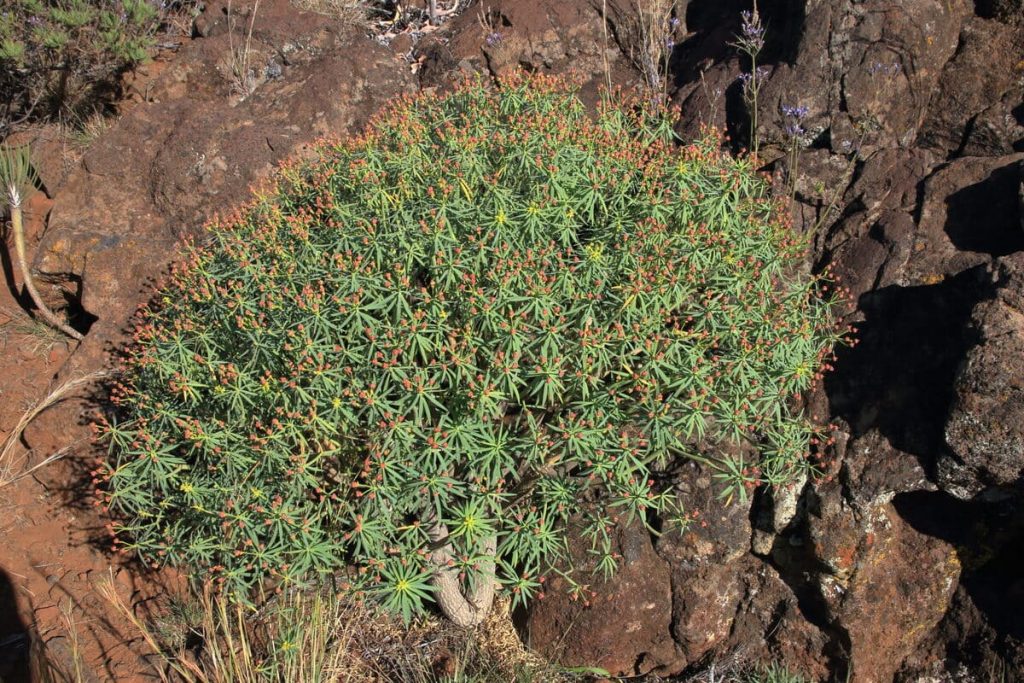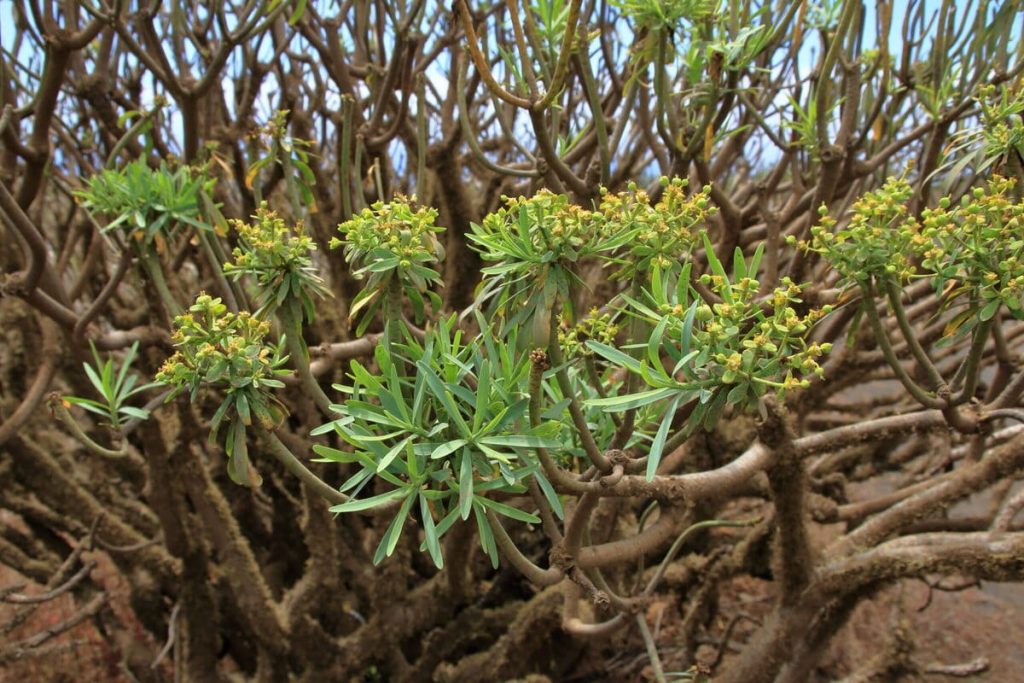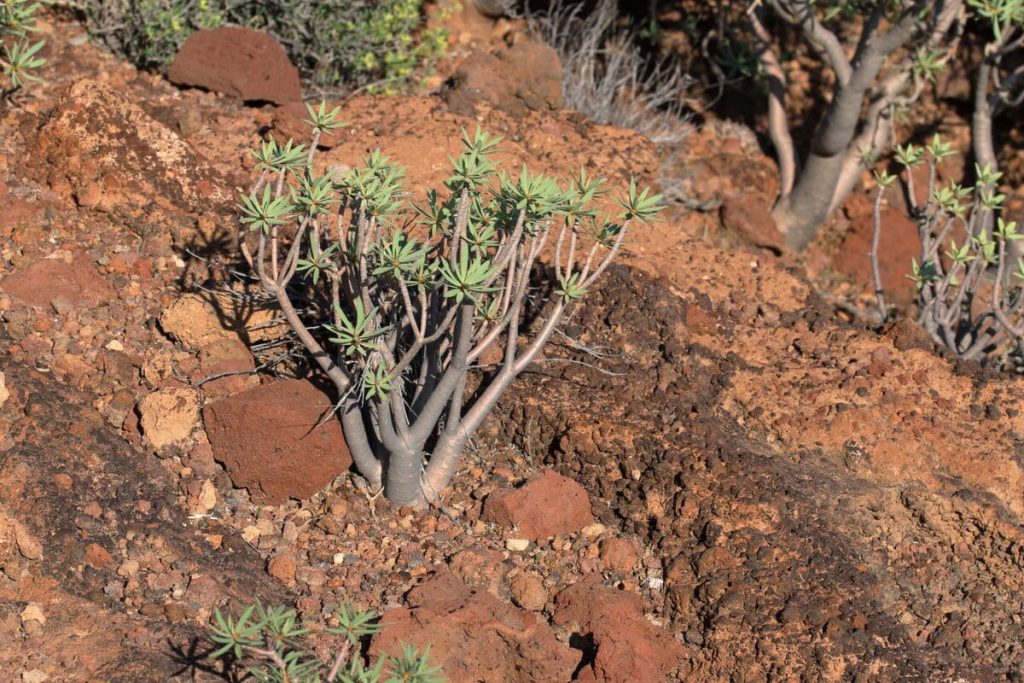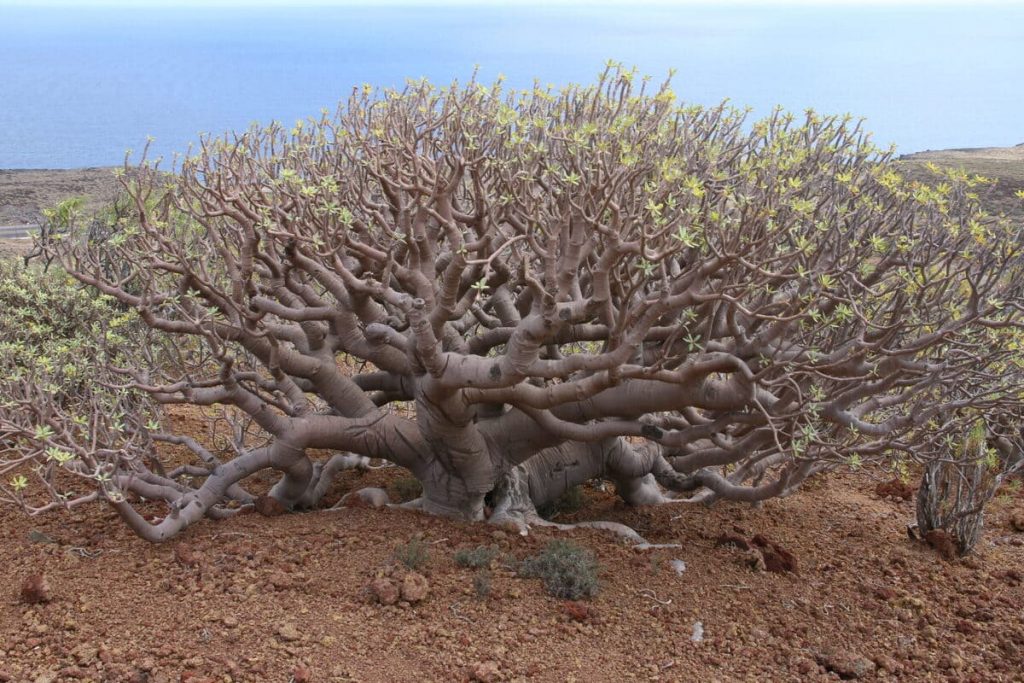Sweet tabaiba or Euphorbia balsamifera is a native species in the Canary Islands. It is a succulent, deciduous shrub, which contains a non-toxic latex and generally reaches a height ranging from 60 cm to one meter high. In this article we will talk about tabaiba, the different types and their benefits.
Sweet or white tabaiba: description
The sweet tabaiba also known as white tabaiba is a woody, deciduous shrub. With a hemispherical crown and branched from the base, with gnarled stems, grayish or reddish-brown color and, generally, with an average height of 1 meter. In shady and sheltered conditions, it can reach more than 3 meters in height. However, in those dry and windy enclaves it presents a creeping and stunted growth habit with branches extended over the ground. Like all tabaibas, at the slightest wound it releases a milky latex, but unlike the others, the sweet tabaiba is not toxic.

Leaves, flowers and fruits of the tabaiba tree
The sweet tabaiba has glaucous green leaves up to 4 cm long, arranged in pseudo rosettes on the terminal part of the stems. They are herbaceous or sub-fleshy, simple, glabrous, sessile, with oblanceolate or oblong-spatulate blade, entire margins and obtuse to acute apex. In periods of drought, especially in the summer months, the white tabaiba loses its leaves showing grayish or reddish-brown stems.
The flowers of the white tabaiba are small, greenish-yellow and arranged in a special cup-shaped structure called ciatio, which contains a single female flower with a tricarpellar ovary and five male flowers reduced to a single stamen pedunculate. The cyathia are solitary and arranged at the end of the branches. It flowers and fruits from late autumn to the spring season.

The fruits of the white tabaiba are capsules of variable pubescence, with three cavities, solitary, globose, just over 1 cm in diameter, reddish or somewhat yellowish, with short peduncles and well-marked grooves. The white tabaiba has two mechanisms to disperse its seeds, one is the autocoria or explosion of the fruits as a result of tensions produced in their tissues and due to heating, in this case the seeds are propelled outward in three opposite directions reaching up to 20 meters away. The other mechanism is the dispersion by animals once the seeds are on the ground, in this case some birds eat the seeds and move them to greater distances.
The Canary Islands and Africa, its natural habitat
The white or sweet tabaiba is a species that inhabits all the Canary Islands and the southern coasts of Morocco, Western Sahara and Mauritania. It is a fairly common plant in the coastal areas of the islands, especially on the southern slopes where it forms genuine tabaibales. On the northern slopes of the islands it is also found, although sharing the space with the bitter tabaiba and other species.

Its altitudinal distribution is between the coastal strip 10-15 meters to 400 meters and in some enclaves can reach 600-800 meters altitude. It is a species that has colonized countless volcanic cones throughout the island territory, creating a landscape of great beauty.
Uses of the sweet or white tabaiba
The sweet tabaiba has had since ancient times countless uses in the Canary Islands. Used in folk medicine as a purgative using several drops of latex. It has also had recognized odontogenic, salivatory and gingival virtues. The latex was prepared as a poultice on the chest to cure colds and flus. It has also been used to treat ailments and inflammations, as well as to cure cold sores and small wounds. In some cases it was even used in the treatment of certain skin tumors.

In veterinary medicine, the latex of the sweet tabaiba was used to fix pieces of leather or cloth in the udders of cattle to force the weaning of the young. It was also used to make the garter or lily to impregnate small twigs and thus hunt birds. The flowers and leaves have been used to feed goats and sheep.
The manufacture of firewood, tinder, tizones and charcoal was also obtained from the white tabaiba. One of the best known uses of the latex of the white tabaiba was the elaboration of a kind of chewing gum. To make it, the latex was cooked by adding a little sugar or the latex was simply left to dry on the plant and then consumed.

At the industrial level, in the late 19th and mid 20th centuries in the south of Tenerife and Gran Canaria , a small industry was created to exploit the latex of the white tabaiba. A system for the collection, processing and transformation of latex was patented.
Among the most unique sweet tabaibas of the Canary Islands is a specimen in the neighborhood of Los Baldíos (San Cristóbal de La Laguna), Tenerife. It has a height of about 4 meters, a crown span of 5 to 6 meters and a trunk diameter of about 50 cm.
If you are interested in learning more interesting facts about the Canary Islands, here is a link to the Explora Canarias section of Marca Canaria.
Paula
Photos: Government of the Canary Islands



